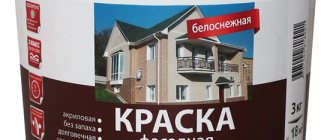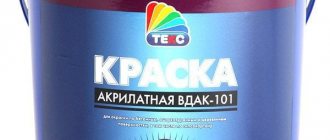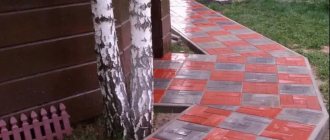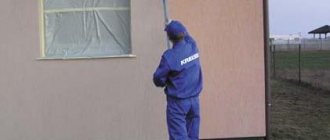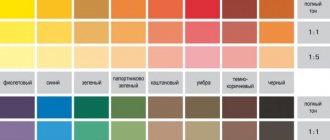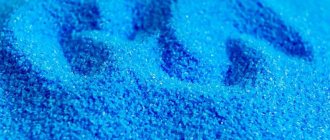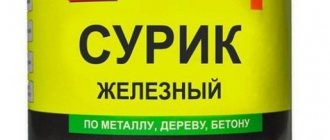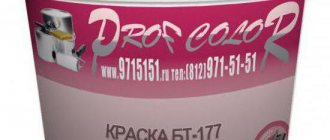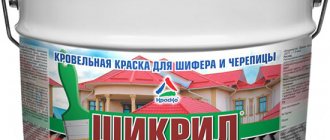Beton-House.com
Website about concrete: construction, characteristics, design. We combine the experience of professionals and private craftsmen in one place
Facade paints will help make the appearance of the building much more attractive.
Most modern buildings are built from concrete. This type of material makes it possible to obtain a very durable structure, which, unfortunately, will have a rather boring gray appearance.
In such a situation, facade paint for concrete will help correct the situation. At the same time, painting the surface will not only change the appearance of the building for the better, but will also improve the performance characteristics of the external walls.
In the article we will look at which façade paints for concrete are preferable to use in this or that case, what requirements paint and varnish materials (paints and varnishes) used on the outside of buildings must meet, and we will also share some secrets of façade work.
- Some nuances of coloring
Facade paints
First of all, it is necessary to clarify exactly what qualities facade paint for concrete should have.
In this case, the requirements will be slightly higher than for the main types of coatings, since:
- firstly, the work is being carried out outside;
- secondly, the concrete itself imposes special requirements.
Properties of the material for external use:
- Perhaps the main requirement for facade finishing is resistance to high humidity and water itself: natural precipitation in the form of rain or snow.
- An equally important property of exterior paint is its resistance to temperature fluctuations. Even if the surface is not exposed to direct sunlight, the wall heats up during the day and cools down at night. In addition, the paint must withstand seasonal temperature changes well.
- Color stability. The paintwork material must easily withstand the effects of ultraviolet radiation, without changing color, chemical or physical characteristics.
- The coating must have good anti-vandal characteristics, be insensitive to the effects of various chemically active substances, and withstand mechanical stress.
- The paint must be non-flammable. Fire safety of facades is a fundamental requirement for putting a building into operation.
The colored coating of concrete must have a high degree of stability to ultraviolet radiation and precipitation
These requirements apply to any façade finishing material.
At the same time, concrete walls add additional characteristics to the list of required characteristics, including:
- High degree of adhesion. Poor adhesion to concrete will quickly lead to peeling of the decorative layer and disruption of the integrity of the protective film.
- Facade paint for concrete must have high vapor permeability to prevent condensation from accumulating inside the concrete wall.
- Paintwork materials must include antibacterial additives to prevent the formation of mold on concrete surfaces.
- When painting concrete, it is important to strengthen the anti-corrosion protection of the metal reinforcement inside the walls.
To summarize, we can say that coatings on concrete for outdoor use must be highly resistant to abrasion and create a fairly strong protective film in order to prevent the impact of negative factors directly on the concrete.
On a note! When choosing, you should also pay attention to the antistatic properties of paints and varnishes. Paint with a high index will get dirty less, which means it will require significantly lower costs for maintaining the facade during operation.
With the help of painting you can turn a boring gray concrete facade into an interesting design solution
Classification of paints for exterior use
Facade paints are divided into several types, depending on the production method and the quality of the resulting surface.
Solvent
By type of solvent:
- water-dispersed or diluted with water;
- solvent or based on another organic solvent: white spirit, xylene.
This factor is very important, since water-dispersed compositions can only be used when the air temperature is positive (plus). Solvent paints can also be used at low temperatures, but they have a strong unpleasant odor, are toxic and are a fire hazard.
Texture
Based on the quality of the resulting surface, paints are divided into textured and smooth. Textured paints make it possible to obtain very interesting surfaces with unique architectural solutions. A smooth surface is not as interesting, but it provides a more durable and dense protective coating.
On a note! Textured paint, as a rule, requires the master to have certain skills in application. Without experience, you should not take on painting yourself.
Possibilities of painting a concrete facade with textured compositions
Color
Depending on the forming substance, concrete paints have a different color palette. At the same time, almost any paint of the same type allows you to mix compositions of different colors to obtain the desired shade. Also, the surface obtained by painting may have different reflectivity.
Based on this property, coating materials are divided into:
- matte,
- semi-matte,
- glossy.
On a note! To cover concrete surfaces, it is better to choose matte paint. Such compositions have a higher degree of vapor permeability.
Modern paintwork materials have a very rich color palette
Painting technology
Before applying paint to concrete, the entire surface should be primed. To do this, choose a primer depending on the paint composition used.
The main indicator of high-quality coloring is the degree of rubbing of the coloring material into the surface.
The coloring method plays a big role in this:
- air gun. This is the best option; with this method, all the pores of the base are filled with paint, which means high-quality adhesion;
- with a brush. A suitable option, but it requires careful rubbing of the material into the surface and is characterized by lengthy work and high labor costs. The brush often gets clogged with sand particles, which requires constant wetting it in a solvent - this can contribute to the formation of stains that will require additional coloring;
- roller An unsuitable option for concrete: painting occurs only on the surface, and it does not get into the pores of the base, which contributes to weak adhesion and rapid peeling.
Coloring should be done in the following way:
- Painting tape should be used to cover the paint border;
- work must be done from top to bottom;
- The brush should be dipped in such a way that it is covered with an even layer of color coating;
- Using an up-and-down movement of a small trajectory, small areas should be painted.
The paint coating must be distributed evenly over the base. If there are insufficiently painted areas, they need to be painted again.
After complete painting, remove the masking tape and use a thin brush to outline the borders.
Thus, painting the facade will not be difficult. The main thing is to choose the right paint and carefully prepare the surface so that there are no problems later.
Different types of paints
The best facade paint for concrete does not mean the most expensive, although price certainly matters when choosing. The properties of paints and varnishes for facade work are such that cheap materials have poor hiding power, and accordingly, more such paint is consumed.
Sometimes budget coatings have good density, but in this case, as a rule, their service life is quite short. Expensive materials, in turn, in addition to the main function of decoration, are often used as a way of minor routine repairs to the physical condition of the facade, masking small cracks or gluing delaminations.
To better understand the types and properties of external coatings, let’s summarize them in a comparative table:
| Paint type | Brief characteristics of paints and varnishes | Flaws |
| Silicate |
| Low degree of elasticity and susceptibility to cracking as a result of mechanical stress. |
| Acrylic |
| Low level of vapor permeability. The price is higher than the average for paints and varnishes. |
| Silicone |
| High price. The indicators of elasticity and abrasion resistance are worse than those of acrylic paints and varnishes. |
| Oily |
| It has a rather unpleasant odor, a long drying period and low vapor permeability. |
| Water-based |
| The coating has low resistance to humidity, chemical influences and temperature changes. |
| Limestone |
| It gets dirty easily, requires regular updating, is easily washed off with water, and fades quickly. |
Consumption per 1m2
| Name | Consumption per 1m2 | Life time |
| Silicate | 0.2 kg | 7 years |
| Oily | 0.2 kg | 5 years |
| Acrylic | 0.4 kg | 10 years |
| Polymer | 0.4 kg | 20 years |
| Vinyl | 0.25kg | 7 years |
| Water-epoxy | 0.250 kg | 8 years |
Note! The data provided is approximate. Consumption depends on the specific material and is indicated on the label.
Painting concrete facades
Painting a concrete composition requires preparation. Some of these activities depend on the type of material chosen. Instructions for using paints and varnishes are prescribed by the manufacturer on the packaging.
In addition, the concrete itself requires careful preparation. As always, before carrying out any work on concrete, the surface should be cleaned, dust-free and primed.
The easiest way to prime is to walk over the surface with paint diluted with water. The proportions are usually 1/10. This primer is guaranteed to adhere well to the base coat.
It is better to treat the surface with a primer using a roller - this will provide a better coating. The main layers of paintwork, usually at least two, can be applied by spray. Moreover, each subsequent layer should be applied after the previous one has dried. It is better to paint hard-to-reach places and wall joints with a brush.
It is more convenient to paint corners and narrow places with a brush
You can learn more about the technology of painting a concrete facade by watching the video in this article.
On a note! Do not use brushes with natural bristles. The hair tends to swell and the brush will leave visible marks.
Table of consumption rates for the most popular types of facade paints for concrete:
| Type of paintwork | Consumption rate (g/m2) | Photo |
| Silicone | 150 — 200 |
|
| Acrylic | 130 — 200 |
|
| Oily | 100 |
|
| Silicate | 150 |
|
| Water-based | 110 — 130 |
|
Some nuances of coloring
As already mentioned, the temperature of the work depends on the type of paint solvent. Paintwork materials on synthetic water-soluble resins can only be applied in the warm season.
As a rule, manufacturers set the lower limit of use at +50C.
- If work must be carried out at negative or near-zero temperatures, then you should give preference to paints based on organic solvents. An accompanying inconvenience will be an unpleasant odor and toxicity, but when working outdoors, the effect of these negative aspects is unimportant.
- If it is necessary to apply a third layer, it is better not to just wait for the second to dry completely, but to let the paint dry deeply. It is better to apply the third layer after a day, at least - even if manufacturers allow work to be carried out earlier.
- Consider the high porosity of concrete. It is better to apply the first layers of paint with more liquid compounds that easily penetrate the pores of the facade.
- Choose the right shade of primer: it is better to put bright colors on a dark primer, pastel shades should be painted white, an opaque primer is the best option for any type of paint.
- In repaint situations, it is sometimes difficult to determine the type of paint. If you need to paint a concrete wall that has previously been coated with a low-absorbency paint, treat the wall with a primer that improves adhesion, such as concrete contact over oil paint.
Water-epoxy
In this case, we are talking about two-component compositions, which are a primer and the paint itself. The packaging is always conveniently marked “A” and “B”, thanks to which it is difficult to make a mistake in mixing the components. After obtaining a homogeneous mixture, all you have to do is wait 15 minutes and you can start working. The composition is applied in two layers with a pause of 24 hours.
Water-epoxy compounds are moisture-resistant and wear-resistant. On average, 1 kg of paint costs 300 rubles, and the consumption will be 250-300 g per “square”. This paint lasts a little less than acrylic – 8 years.
One of the disadvantages is that epoxy components do not allow the production of compositions in a wide variety of colors. In addition, such paints contain dangerous components. Therefore, it is better to use paints of this type only for facade decoration.
Painting technology
Before applying paint to concrete, the entire surface should be primed. To do this, choose a primer depending on the paint composition used.
The main indicator of high-quality coloring is the degree of rubbing of the coloring material into the surface.
The coloring method plays a big role in this:
- air gun. This is the best option; with this method, all the pores of the base are filled with paint, which means high-quality adhesion;
- with a brush. A suitable option, but it requires careful rubbing of the material into the surface and is characterized by lengthy work and high labor costs. The brush often gets clogged with sand particles, which requires constant wetting it in a solvent - this can contribute to the formation of stains that will require additional coloring;
- roller An unsuitable option for concrete: painting occurs only on the surface, and it does not get into the pores of the base, which contributes to weak adhesion and rapid peeling.
Coloring should be done in the following way:
- Painting tape should be used to cover the paint border;
- work must be done from top to bottom;
- The brush should be dipped in such a way that it is covered with an even layer of color coating;
- Using an up-and-down movement of a small trajectory, small areas should be painted.
The paint coating must be distributed evenly over the base. If there are insufficiently painted areas, they need to be painted again.
After complete painting, remove the masking tape and use a thin brush to outline the borders.
Thus, painting the facade will not be difficult. The main thing is to choose the right paint and carefully prepare the surface so that there are no problems later.
How to prepare
Before applying the composition, it is necessary to carefully prepare the surface:
clean the walls from dirt and dust;
eliminate existing defects using plaster;
prime the walls (to improve the adhesion of the coating to the concrete).
The end result should be as flat and smooth a surface as possible.
The process of preparing concrete walls for painting is described in detail in the following video:
Peculiarities
Facade paint is a finishing material that should not only be attractive, but also wear-resistant. The modern construction market offers high-quality coloring mixtures for decorating wooden bases.
The distinctive characteristics of exterior paints are the following parameters:
They prevent water and moisture from being absorbed into the wood. Thanks to this characteristic, the noble material does not swell or lose shape if it comes into contact with water.
- By choosing high-quality facade paint, you will protect wooden bases from premature aging.
- In addition, most facade paints for wood prevent the formation of mold or mildew on it, which adversely affects not only the appearance of the house, but also the structure of the natural material. Also, by using a reliable coloring composition, you will protect the wood from pests, which are usually not so easy to get rid of.
- Facade paint is designed to protect the wooden base from the negative effects of sunlight. Without such finishing, the wood can quickly dry out and become cracked under the influence of ultraviolet radiation.
- If you want to achieve a unique design effect, then you should choose an exterior paint that will highlight the attractive structure of the wood. Thanks to this characteristic, such compositions are enviably popular among buyers.
- Wood finished with high-quality and beautiful paint will not suffer from climate change.
- The painted facade is not afraid of abrasion.
- Facade paints, as a rule, are frost-resistant and are not afraid of temperature changes.
The rich assortment of these products allows consumers to choose the option they like without much difficulty and long searches.
Manufacturers
There are many companies that supply paint and varnish materials for finishing the facades of houses. But not all of them are able to solve the problem really well and lastingly.
- offers its product at the best price, which fully corresponds to its quality. The entire line of this manufacturer lasts at least 7 years, thanks to an exceptionally strong polymer film with high vapor permeability. The company sells acrylic and siloxane, silicate and silicone paints and varnishes; There are universal compositions and mixtures for painting facades used in extreme conditions.
- Among the best paints are products under the Terraco brand. This manufacturer produces matte water-based paints for interior use, and silicone and acrylic paints for exterior use. Vinyl universal paint "Terralux" with a matte effect is suitable for almost all surfaces inside and outside the house.
- Caparol products have been produced for over a hundred years, while the company always follows the latest technical innovations. Each option fully complies with the Blue Angel label, which denotes a very high level of environmental performance.
- Ceresit brand products are very resistant to acids and alkalis and mechanical abrasion. Other performance characteristics and color parameters are also very high. The coating is supplied in cans with a capacity of 15 liters each, meaning most walls can be painted with the contents of one can.
- The Dali brand is a frost-resistant paint that can create a high-quality coating at temperatures down to –20 degrees. Its durability is quite high, even in contact with water. At temperatures from –50 to + 50 degrees, the warranty service life is at least 10 years.
You can find out many important recommendations for choosing facade paint below.
Consumer recommendations
- Many consumers apply paint to plaster. It is noted that the decorative surface usually has a clearly defined relief, so the higher the surface relief, the greater the paint consumption.
- You can begin painting work only after completion of preparation. If the surface of the walls has smooth and convex areas, you need to start painting with those that protrude.
- Painting on a plastered surface has several features. It is necessary to choose the right paint, prepare the walls and correctly apply the mixture to them. This is the only way to achieve the desired result.
